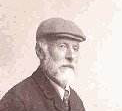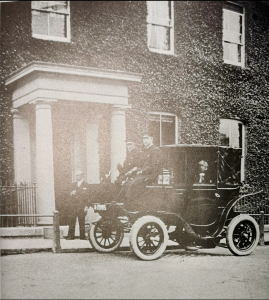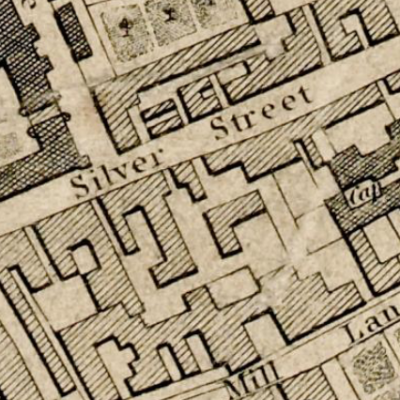Search by topic
- archaeology
- Building of Local Interest
- charity
- church
- crime
- dressmaker
- fire
- Great Eastern Railway
- Listed building
- Mapping Relief
- medieval
- oral history
- poverty
- Public House
- Rattee & Kett
- Religious House
- Roman
- scholar
- school
- Then and Now
- tudor
- women
- work
- world war one
- world war two
Search by text
 Gerald Francis Cobb
Gerald Francis CobbThe Hermitage, Silver Street
The History ofthe Hermitage, Silver Street
1853
Swan Hurrell had built and occupied the house by this year. In ‘A House By The River’ E M Keynes writes: It is impossible to decide how much of the present Hermitage forms part of the original house – it has been so much altered, added-to, and sub-divided… Later on, the stabling was pulled down and the three-storeyed west end of the house was built in its place, probably by Dr Parkinson. … What certainly does remain of of Swann Hurrell’s house is the drawing-room with the bedroom over it in the big round bay facing the garden and in all ,likelihood, also the long narrow verandah, supported by elegantly ornamented iron pillars …. Most of the cellars must also belong to the 1853 house.
1861
Swann Hurrell moved to 30 Thompson’s Lane where his back door opened onto his foundry. The house was let to a Mrs Sarah Miller.
1870
After death of Mrs Miller the house was let to a Richard Miller, probably her son, living in Newnham Terrace.
1874 Hermitage
Rev. Stephen Parkinson
Parkinson bought the freehold; he was a celebrated teacher of maths at St John’s College. He bought the house on the occasion of his marriage to Elizabeth Lucy Whateley; her money paid for a lot of enlargement and ‘improvement’. It was now that the house was named ‘Hermitage’ even though the original site of that name must have been further to the east.
1881 The Hermitage
Stephen Parkinson, 57, doctor of divinity, b Yorks
Elizabeth Lucy, 45, b Birmingham
Susan Mills, 32, cook, b Cheltenham
Kate Cripps, 26, ladys Maid, b Gloucs
Jane Gray, 23, housemaid, b Cambridge
Marsha Brown, 18, kitchenmaid, b Suffolk
1889
Stephen Parkinson died and his widow continued to live at the house.
1891
Elizabeth Lucy Parkinson, widow, living on her own means [in 1893 Elizabeth married Gerard F Cobb]
Mary Routh, visitor, 19, b Cambs
Kate Cripps, 36, maid
Jane Gray, cook
Mary A Gawthorp, 33, housemaid, b Histon
Sarah J Symonds, 22, kitchen maid, b Teversham
Stewart Nottage, 16, page, b Essex
1895
Elizabeth Lucy Parkinson remarried, Gerard Francis Cobb (1838 – 1904)
1901
Gerard Francis Cobb (1838-1904), musical composer, 62, b Kent [junior bursar of Trinity College until his marriage in 1893 when he resigned his position as was the custom]
Another source of information is the MusicWebsite.
Jane Gray, 42, cook, b Cambridge
Sarah Hamdy, 31, housemaid, b Somerset
Elizabeth A Thorogood, 20, kitchenmaid, b Cambs
Reuben Banbrook, 20, footman, b Warwicks
In Period Piece, Gwen Raverat describes the Hermitage and ‘Mrs C’, p82. A drawing of the Monte Cobbeo which Cobb had erected to propose to Elizabeth Parkinson on in the Trinity Fellow’s Garden can be found on the Zanditon website.
More information about Gwen Raverat can be found here:
http://www.creatingmycambridge.com/history-stories/gwen-raverat/
1904
Gerard Cobb died and Mrs Cobb née Whateley continued living at the house until her death in 1913.
1913 The Hermitage
Mrs Gerard Cobb
She left the house in her will to St John’s College.
1913 – 1917
House was let by St John’s to Rev J Plowden Wardlaw, Chaplain of St Edward’s.
1917 – 1919
Used by the War Office as Rest Home for officers.
1919
University lodging house run by H C H Coppins. He had to provide at least ten sets of rooms.
1931
St Catharine’s lodging house
1937
Guest house run by Miss Lucy Cragoe.
Students who lodged there include former Archbishop of Canterbury Dr Ramsey, Dr Frisch Nobel Prize winner, Sir Lewis Casson and Dame Sybil Thorndyke.
1954
Leased by the Association for promoting a Third Foundation for Women in the University, the forerunner of New Hall.
1958
Leased direct to New Hall until such time as new college buildings ready.
1962 (21)
R Bagley, grocer
Contribute
Do you have any information about the people or places in this article? If so, then please let us know using the Contact page or by emailing capturingcambridge@
License
This work is licensed under CC BY-NC-SA 4.0







